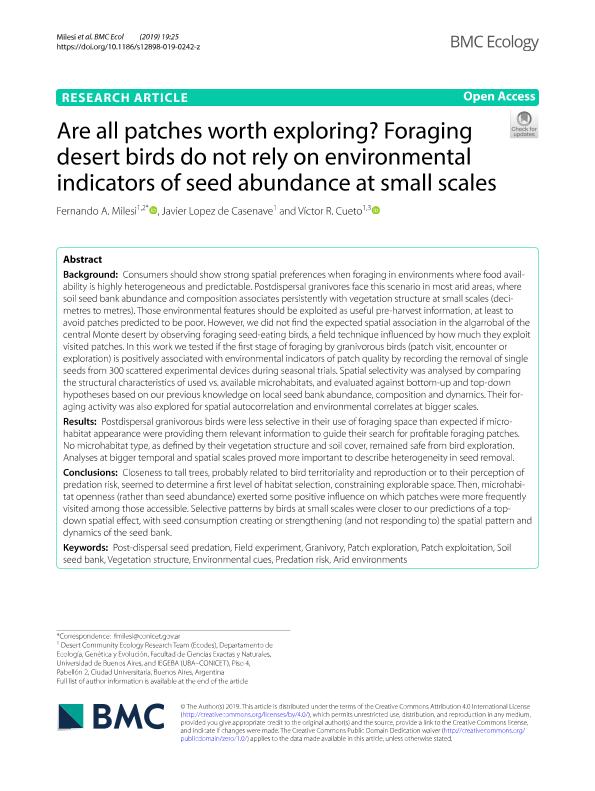Mostrar el registro sencillo del ítem
dc.contributor.author
Milesi, Fernando Adrian

dc.contributor.author
Lopez de Casenave, Javier Nestor

dc.contributor.author
Cueto, Víctor

dc.date.available
2021-01-07T20:44:14Z
dc.date.issued
2019-06
dc.identifier.citation
Milesi, Fernando Adrian; Lopez de Casenave, Javier Nestor; Cueto, Víctor; Are all patches worth exploring? Foraging desert birds do not rely on environmental indicators of seed abundance at small scales; BioMed Central; BMC Ecology; 19; 1; 6-2019; 1-17
dc.identifier.issn
1472-6785
dc.identifier.uri
http://hdl.handle.net/11336/121796
dc.description.abstract
Background: Consumers should show strong spatial preferences when foraging in environments where food availability is highly heterogeneous and predictable. Postdispersal granivores face this scenario in most arid areas, where soil seed bank abundance and composition associates persistently with vegetation structure at small scales (decimetres to metres). Those environmental features should be exploited as useful pre-harvest information, at least to avoid patches predicted to be poor. However, we did not find the expected spatial association in the algarrobal of the central Monte desert by observing foraging seed-eating birds, a field technique influenced by how much they exploit visited patches. In this work we tested if the first stage of foraging by granivorous birds (patch visit, encounter or exploration) is positively associated with environmental indicators of patch quality by recording the removal of single seeds from 300 scattered experimental devices during seasonal trials. Spatial selectivity was analysed by comparing the structural characteristics of used vs. available microhabitats, and evaluated against bottom-up and top-down hypotheses based on our previous knowledge on local seed bank abundance, composition and dynamics. Their foraging activity was also explored for spatial autocorrelation and environmental correlates at bigger scales.
Results: Postdispersal granivorous birds were less selective in their use of foraging space than expected if microhabitat appearance were providing them relevant information to guide their search for profitable foraging patches. No microhabitat type, as defined by their vegetation structure and soil cover, remained safe from bird exploration. Analyses at bigger temporal and spatial scales proved more important to describe heterogeneity in seed removal.
Conclusions: Closeness to tall trees, probably related to bird territoriality and reproduction or to their perception of predation risk, seemed to determine a first level of habitat selection, constraining explorable space. Then, microhabitat openness (rather than seed abundance) exerted some positive influence on which patches were more frequently visited among those accessible. Selective patterns by birds at small scales were closer to our predictions of a top-down spatial effect, with seed consumption creating or strengthening (and not responding to) the spatial pattern and dynamics of the seed bank.
dc.format
application/pdf
dc.language.iso
eng
dc.publisher
BioMed Central

dc.rights
info:eu-repo/semantics/openAccess
dc.rights.uri
https://creativecommons.org/licenses/by/2.5/ar/
dc.subject
Post-dispersal seed predation
dc.subject
Field experiment
dc.subject
Granivory
dc.subject
Patch exploration
dc.subject
Patch exploitation
dc.subject
Soil seed bank
dc.subject
Vegetation structure
dc.subject
Environmental cues
dc.subject
Predation risk
dc.subject
Arid environments
dc.subject.classification
Ecología

dc.subject.classification
Ciencias Biológicas

dc.subject.classification
CIENCIAS NATURALES Y EXACTAS

dc.subject.classification
Zoología, Ornitología, Entomología, Etología

dc.subject.classification
Ciencias Biológicas

dc.subject.classification
CIENCIAS NATURALES Y EXACTAS

dc.title
Are all patches worth exploring? Foraging desert birds do not rely on environmental indicators of seed abundance at small scales
dc.type
info:eu-repo/semantics/article
dc.type
info:ar-repo/semantics/artículo
dc.type
info:eu-repo/semantics/publishedVersion
dc.date.updated
2020-11-18T20:42:43Z
dc.journal.volume
19
dc.journal.number
1
dc.journal.pagination
1-17
dc.journal.pais
Reino Unido

dc.journal.ciudad
Londres
dc.description.fil
Fil: Milesi, Fernando Adrian. Consejo Nacional de Investigaciones Científicas y Técnicas. Centro Científico Tecnológico Conicet - Patagonia Norte. Instituto de Investigaciones en Biodiversidad y Medioambiente. Universidad Nacional del Comahue. Centro Regional Universidad Bariloche. Instituto de Investigaciones en Biodiversidad y Medioambiente; Argentina. Consejo Nacional de Investigaciones Científicas y Técnicas. Oficina de Coordinación Administrativa Ciudad Universitaria. Instituto de Ecología, Genética y Evolución de Buenos Aires. Universidad de Buenos Aires. Facultad de Ciencias Exactas y Naturales. Instituto de Ecología, Genética y Evolución de Buenos Aires; Argentina. Universidad de Buenos Aires. Facultad de Ciencias Exactas y Naturales. Departamento de Ecología, Genética y Evolución. Grupo de Investigación en Ecología de Comunidades del Desierto; Argentina
dc.description.fil
Fil: Lopez de Casenave, Javier Nestor. Consejo Nacional de Investigaciones Científicas y Técnicas. Oficina de Coordinación Administrativa Ciudad Universitaria. Instituto de Ecología, Genética y Evolución de Buenos Aires. Universidad de Buenos Aires. Facultad de Ciencias Exactas y Naturales. Instituto de Ecología, Genética y Evolución de Buenos Aires; Argentina. Universidad de Buenos Aires. Facultad de Ciencias Exactas y Naturales. Departamento de Ecología, Genética y Evolución. Grupo de Investigación en Ecología de Comunidades del Desierto; Argentina
dc.description.fil
Fil: Cueto, Víctor. Consejo Nacional de Investigaciones Científicas y Técnicas. Oficina de Coordinación Administrativa Ciudad Universitaria. Instituto de Ecología, Genética y Evolución de Buenos Aires. Universidad de Buenos Aires. Facultad de Ciencias Exactas y Naturales. Instituto de Ecología, Genética y Evolución de Buenos Aires; Argentina. Universidad de Buenos Aires. Facultad de Ciencias Exactas y Naturales. Departamento de Ecología, Genética y Evolución. Grupo de Investigación en Ecología de Comunidades del Desierto; Argentina. Consejo Nacional de Investigaciones Científicas y Técnicas. Centro Científico Tecnológico Conicet - Patagonia Norte. Centro de Investigación Esquel de Montaña y Estepa Patagónica. Universidad Nacional de la Patagonia San Juan Bosco. Centro de Investigación Esquel de Montaña y Estepa Patagónica; Argentina
dc.journal.title
BMC Ecology
dc.relation.alternativeid
info:eu-repo/semantics/altIdentifier/url/https://bmcecol.biomedcentral.com/articles/10.1186/s12898-019-0242-z
dc.relation.alternativeid
info:eu-repo/semantics/altIdentifier/doi/http://dx.doi.org/10.1186/s12898-019-0242-z
Archivos asociados
